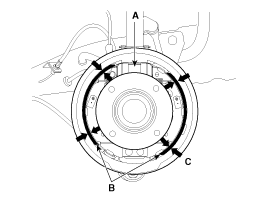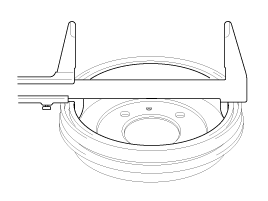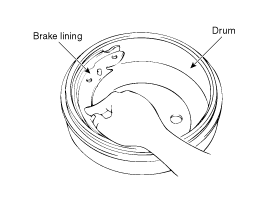 Kia Rio: Inspection
Kia Rio: Inspection
| •
|
Frequent inhalation of brake pad dust, regardless of material
composition, could be hazardous to your health.
|
| •
|
Avoid breathing dust particles.
|
| •
|
Never use an air hose or brush to clean brake assemblies.
|
|
| •
|
Contaminated brake linings or drums reduce stopping ability.
|
| •
|
Block the front wheels before jacking up the rear of the
vehicle.
|
|
|
1. |
Raise the rear of the vehicle, and make sure it is securely supported.
|
|
2. |
Release the parking brake, and remove the rear brake drum.
|
|
3. |
Check the wheel cylinder (A) for leakage.

|
|
4. |
Check the brake linings (B) for cracking, glazing, wear, and contamination.
|
|
5. |
Measure the brake lining thickness (C).Measurement does not include
brake shoe thickness.
Brake lining thickness
Standard: 4.5 mm (0.177 in)
Service limit: 1.0 mm (0.039 in)
|
|
|
6. |
If the brake lining thickness is less than the service limit,
replace the brake shoes as a set.
|
|
7. |
Check the bearings in the hub unit for smooth operation. If it
requires servicing, replace it.
|
|
8. |
Measure the inside diameter of the brake drum with inside vernier
calipers.
Drum inside diameter
Standard: 203.2 mm (8.0 in)
Service limit: 205.2 mm (8.079 in)
Drum roundness
Service limit: 0.06 mm (0.00236 in)
|

|
|
9. |
If the inside diameter of the brake drum is more than the service
limit, replace the brake drum.
|
|
10. |
Check the brake drum for scoring, grooves, and cracks.
|
|
11. |
Inspect the brake lining and drum for proper contact.

|
|
12. |
Inspect the wheel cylinder outside for excessive wear and damage.
|
|
13. |
Inspect the backing plate for wear or damage.
|
•
Do not spill brake fluid on the vehicle: it may damage
the paint; if brake fluid does ...
See also:
Troubleshooting
Ignition System
Symptom
Suspect Area
Remedy
Engine will not start or is hard to
start (Cranks OK)
Ignition lock switch
Inspect igni ...
Components
1. Guide rod bolt
2. Bleed screw
3. Caliper carrier
4. Caliper body
5. Brake pad
6. Pad retainer
...
Replacement
Rear Brake Pads
1.
Loosen the guide rod bolt (B) and then remove the rear caliper
body (A).
Tightening torque:
21.6 ~ 31 ...
 Kia Rio: Inspection
Kia Rio: Inspection Installation
Installation





